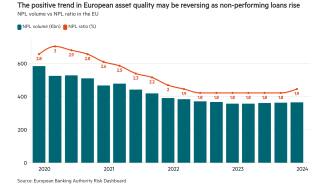Amprion, one of the four transmission system operators for electricity in Germany, made its debut in the international corporate bond market in September 2021 with an €800m benchmark issue, as part of its strategy to invest approximately €24bn in transforming the energy system over the next decade. In September 2022, Amprion returned to the international capital markets with its first green bond to raise a further €1.8bn.
Chief financial officer Peter Rüth describes Amprion as an essential company at the core of the energy transition in Europe. In Germany, the coalition government has brought forward the target for the country to be climate neutral by five years to 2045.
Amprion has resolute targets for 80% of energy to come from renewable sources by 2030, which requires investment to change the electricity grid. The transmission system operator’s sustainability report has carbon reduction targets for Scope 1 greenhouse gas (GHG) emissions that a company makes directly and, most importantly for Scope 2, emissions a company makes indirectly. It aims to reduce GHG emissions by at least 63% by 2032 over both scopes.
Mr Rüth says the first and biggest task is to pave the way to a climate-neutral system, but it is also important to ensure the required stability, especially in the transition phase. “Our business model is green, so it was self-evident to raise funds in a green framework,” he adds.
Strategic approach
Amprion pursues a ‘bridge-to-bond’ approach, which means that the firm uses short-term instruments first, with the aim of moving to long-term instruments once it has reached a benchmark volume.
To issue its green bond, it had to first complete several processes. When Amprion made its debut in the international bond market in 2021, Moody’s had given the firm a rating of Baa1 with a negative outlook. This time, it had extensive discussions with the rating agency to explain its business model and especially the regulatory model, which Mr Rüth says clarified the low risks involved.
Our business model is green, so it was self-evident to raise funds in a green framework
Amprion operates in a clear regulatory framework on a legal basis, which is critical because the model allows the company to invest in an environment where the return on investment is legally secure. As a result, the rating outlook was raised back to stable in July 2022.
In April 2022, the company achieved its first environmental, social and governance risk rating of “low risk — 12.8” from Sustainalytics, which Mr Rüth describes as an outstanding result. It started to work on a green finance framework in the first half of last year, which covers all instruments, not just bonds, and this was published in September.
The green bond consisted of an €800m tranche with a five-year term and a second €1bn tranche with a 10-year maturity, with interest coupons of 3.45% and 3.971%, respectively. Amprion decided on a dual-tranche green bond because of the relationship with its business model. The transmission system operator is long-term oriented towards the next 10 to 15 years, while, in contrast, investors are currently having to look carefully at an energy market that is affected by geopolitical challenges, rising interest rates and the fear of recession.
Amprion’s banks also recommended that it would be better to split the duration. Mr Rüth says it has a good relationship with its eight core banks and a rolling procedure where they play different roles depending on the transaction. He felt very comfortable with the three joint global coordinators — Commerzbank, SEB and UniCredit — who were also active bookrunners alongside Landesbank Baden-Württemberg and ING, as they were all heavily experienced in the green bond market. Bayerische Landesbank, DZ Bank and Landesbank Hessen-Thüringen were additional bookrunners.
“We wanted to raise nearly €2bn, which was perhaps too much volume for one tranche. In the end, it proved that [splitting] was a good idea,” adds Mr Rüth.
Green plans
Investors had many questions around Amprion’s green business model to understand the sustainability strategy. In addition to explaining its business model, the company had to negotiate a volatile market. The first two days of the roadshow were on Monday and Tuesday, and the feedback from more than 40 investors was positive.
However, on Tuesday evening the Dow Jones index fell 5%, but Amprion decided that the feedback meant it could still go to market the next day. “In the end, we were oversubscribed nearly five times and, as we raised €1.8bn, it was a really big success,” he adds.
The proceeds from the green bond will be used exclusively for projects that meet the criteria of Amprion’s Green Finance Framework. Mr Rüth expects green bonds to undoubtedly become a very important part of the company’s financial toolkit. He adds: “Hopefully, it will not be the only green instrument as we may work on green commercial paper, loans and syndicated credit lines with our eight core banks.”
Investments required for the energy transition means Amprion will need to become a frequent issuer and he is sure the company will come back to the market in 2023.












